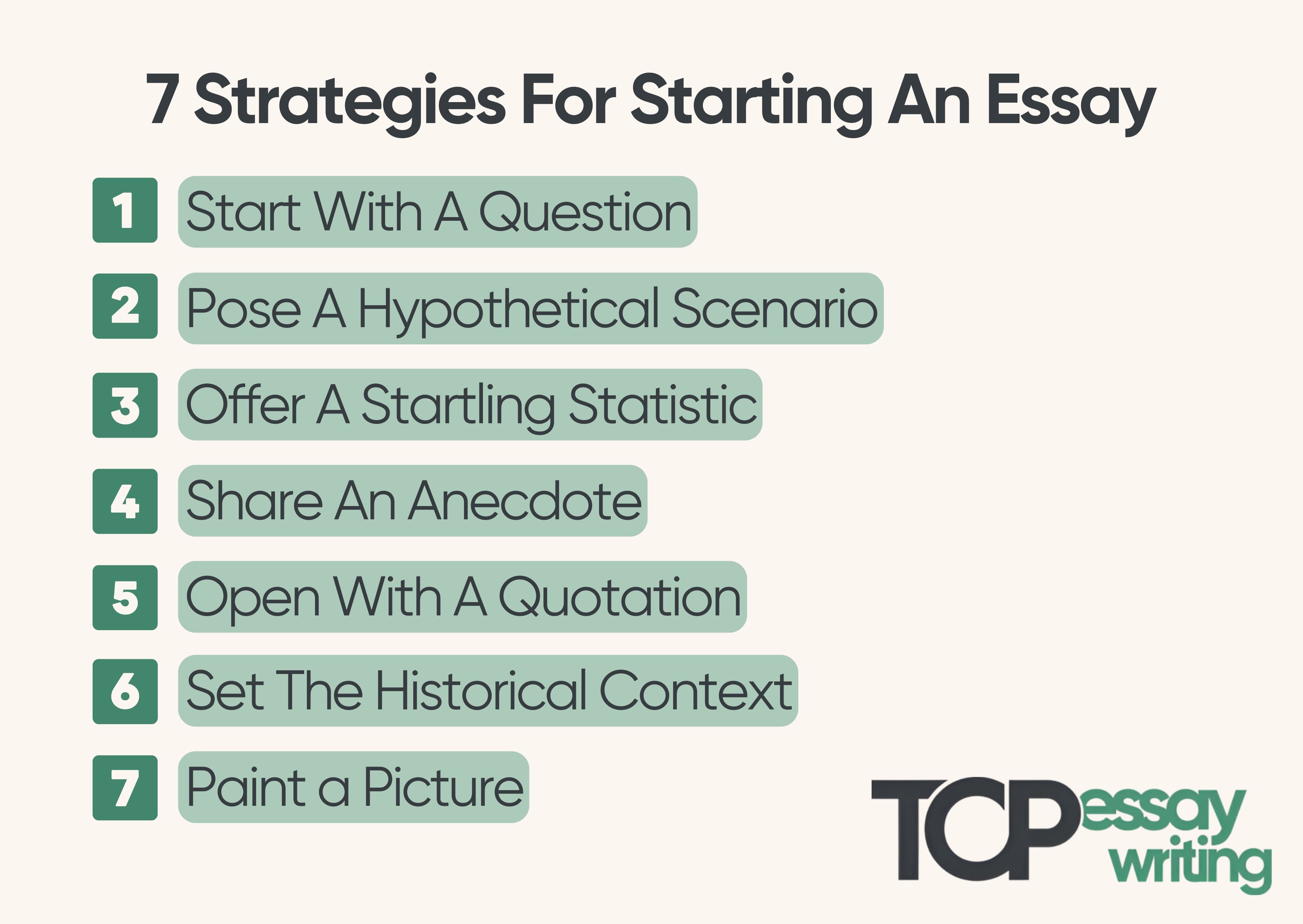Top Special Offer! Check discount
Get 13% off your first order - useTopStart13discount code now!
How to Start an Essay: Techniques for Essay Introductions
When starting an essay, writers often face a few common obstacles. Some suffer from what is known as the “blank page syndrome,” where they stare at an empty page/screen and have no idea where to begin. Others find it challenging to organize their thoughts or worry that their introduction isn’t interesting enough to hook their reader. These initial failures can make even the most experienced writers search the Internet for good ways to start a college essay. In this article, we will answer the question “How to start an essay?” by offering strategies suitable for different kinds of writing. A good introduction to an essay should be:
- Engaging, grabbing the reader’s attention right off the bat
- Clear, stating the main point or thesis upfront
- Concise, without any fluff or unnecessary information
- Relevant, directly setting up the discussion or argument of the essay
- Structured, smoothly leading the reader to the main body of the essay
Seven Best Ways to Start an Essay
As an old saying goes, “Different strokes for different folks.” The same is true for essay introductions. Each essay is different, but they all benefit from a creative introduction. Most essays have one thing in common: they need to hook the reader to make them want to stick around and read more, which is exactly why we aim to provide some great essay hook examples below. So, check out the best strategies that are easy to implement.
1. Start With a Question
This powerful technique will help you spark curiosity and engage readers from the beginning of your essay. It encourages you to find the answer to the question in the central part of your essay.
| Aspect | Details |
|---|---|
| What it’s about | Posing a thought-provoking question to engage the reader’s curiosity. |
| Suitable essay types | Narrative, persuasive, expository. |
| Example | "What if you could relive one day of your life? Which day would you choose and why?" |
| Expert advice | Use a question that relates directly to the essay’s theme to ensure it's intriguing and relevant. |
2. Pose a Hypothetical Scenario
This is an effective method for starting an essay that involves creating an imaginary situation to vividly illustrate the main thesis or argument. This approach serves several purposes: engagement, clarity of argument, persuasiveness, and depth of presentation.
| Aspect | Details |
| What it’s about | Creating a hypothetical scenario to illustrate the essay's main point is undeniably the best way to start an introduction. |
| Suitable essay types | Persuasive, argumentative, expository. |
| Example | "Imagine a world where clean energy is not just an option, but the only option." |
| Expert advice | Craft a scenario that directly supports your argument or thesis statement. |
3. Offer a Startling Statistic
This method is an excellent tool for creating a basis for an exciting discussion. This approach can be especially effective in essays where reliable data can emphasize the importance of the topic under discussion.
| Aspect | Details |
| What it’s about | Opening with a surprising fact or statistic to capture attention. |
| Suitable essay types | Argumentative, expository, persuasive. |
| Example | "Did you know that less than 10% of the ocean has been explored?" |
| Expert advice | Choose a statistic that shocks or provokes thought to ensure it packs a punch. |
4. Share an Anecdote
Anecdotes can create a personal connection between the author and the reader. By sharing personal experiences or observations, you can evoke empathy or sympathy, strengthening the persuasiveness of their arguments.
| Aspect | Details |
| What it’s about | Telling a brief, relevant story to illustrate a larger point. |
| Suitable essay types | Narrative, descriptive, reflective. |
| Example | "Last summer, I learned the true meaning of perseverance when I attempted to hike Mt. Helix." |
| Expert advice | Keep the anecdote short and sweet to maintain focus and flow. |
5. Open with a Quotation
Starting with a quote gives the essay authority by associating its arguments with the authority of a recognized expert or historical figure. A well-chosen quote can become a thematic basis for an essay.
| Aspect | Details |
| What it’s about | Starting with a relevant quote from a famous or significant figure. |
| Suitable essay types | Persuasive, analytical, expository. |
| Example | "As Mahatma Gandhi once said, ‘Be the change that you wish to see in the world." |
| Expert advice | Ensure the quote enhances your thesis rather than just taking up space. |
6. Set the Historical Context
By outlining historical events or conditions, the introduction contextualizes the topic, showing its development over time and its relevance in the current scenario. This method helps the reader understand why the topic is essential today.
| Aspect | Details |
| What it’s about | Provide background information that sets up the essay topic in a historical framework. |
| Suitable essay types | Analytical, expository, reflective. |
| Example | "Before the Industrial Revolution, most societies were predominantly agrarian." |
| Expert advice | Link the historical detail directly to the essay question to keep it relevant. |
7. Paint a Picture
The mood and atmosphere created by the opening description can set the emotional tone for the rest of the essay. Whether calm, tense, nostalgic, or joyful, this tone helps shape the reader's emotional response to the following content.
| Aspect | Details |
| What it’s about | Using descriptive language to create a vivid scene that relates to the essay's theme. |
| Suitable essay types | Descriptive, narrative. |
| Example | "The sun dipped below the horizon, bathing the beach in a warm, golden glow." |
| Expert advice | Ensure the scene is directly tied to the essay’s main point to avoid confusing your reader. |
Strategies When Stuck on the Introduction
Have you ever looked at that little blinking cursor, wondering how to start a good essay, and had no idea where to begin? Most writers have experienced this predicament. Writing the opening of your essay can be a big hurdle, but it doesn’t have to be. Consult the best essay writing organization for some guidance. Or, simply try these five tips from our pros to get your paper started with a bang.
- Just jump in: Get started writing the body of your essay, which is almost always easier than composing a flawless introduction. Sometimes, the introduction will follow naturally once the essay’s main points are clear.
- Simple placeholder: When you don’t know what to write, just put in a placeholder paragraph or two. Write down the basic outline of what you want to say, then return later to clean up your opening.
- Start with a fact or statistic: If you have a strong fact or statistic related to your topic, sharing it is among the top good ways to start an essay. This will help grab the reader’s attention and signal the direction your arguments will take, which makes it a helpful starting point.
- Ask a question: Introduce your essay’s theme by asking a question relevant to the subject matter. This is a great way to connect with your reader and structure your discussion. This connection makes it easier to transition into the main topic.
- Take a break: If you really can’t come up with anything, stop working for a while. Go for a walk, listen to some music, or just relax. A short break can reset your mind so that it can welcome new ideas.
What to Avoid When Writing an Essay Intro
Finding the best way to start an essay – that is, creating an effective introduction – is immensely important, as the introduction sets up the rest of your essay’s detailed argument and analysis. So, as you strive to create a good opening, it’s easy to fall into some of the standard traps that can undermine your introduction. If you want to avoid these hurdles, hire a graduate essay writer to help. Alternatively, use the tips below to avoid making mistakes:
- Don’t use generic and vague statements. “In the world today…” or “Throughout history…” is the weakest type of opening sentence. It’s uninformative and general and doesn’t tell us exactly what you’ll be writing about in your essay. Instead, begin with a specific, interesting, and clear point that will relate directly to your key argument.
- Don’t overload the introduction. All tips for the best ways to start a college essay emphasize that the introduction should be short. It should not disrupt, overwhelm, or bore the reader by providing too many details or statistics. Limit the introduction to one or two main points that support a direction toward the thesis statement.
- Avoid cliches. Clichés add nothing to your writing, so they are far from the best way to start a college essay. They can give your essay a decidedly flat feel. Steer clear of classic clichés to keep your opening fresh. If needed, check out essay examples to look for great introductions.
- Cut out excessive details. All information in your introduction should pertain to the argument or viewpoint of your essay. Don’t allow the paragraph to wander into sidebar issues that don’t affirm your thesis.
- Avoid obvious quotations. It’s a common strategy to start an essay with a quotation, but using a too well-known quotation can make your work seem derivative. If you decide to begin with a quotation, be sure it’s distinctive and clearly relevant to your topic.
- No ambiguity. Make sure that you are as clear as possible in your introduction; ambiguity can confuse a reader and cloud your thesis. Clarity starts at the beginning.
A Confident Start
Wondering what is the best way to start an essay? Discover your own way! Play with essay introduction techniques to see what works best for your type of essay. The next time you pick up a pen to write an essay, start with a fact, question, or description and see what each of them does to set up your argument, thesis, and point of view. Maybe you’ll find something new in the process that will ignite your writing. The more you play around and try new things, the better you will get, and the easier time you’ll have finding the best way to start a paper, every time!




